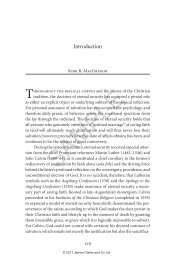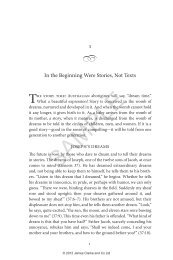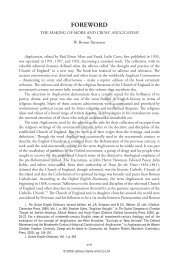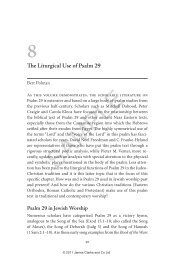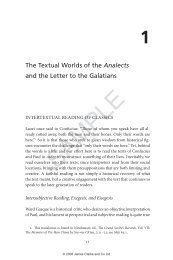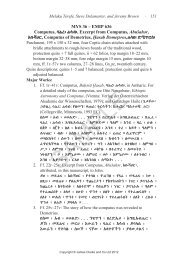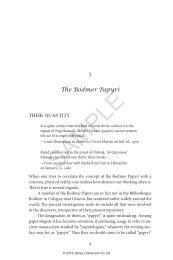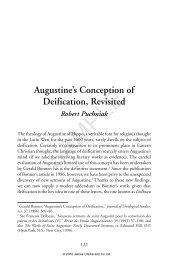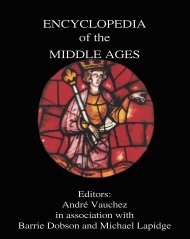Chapter 3: The Spatiality of God - James Clarke and Co Ltd
Chapter 3: The Spatiality of God - James Clarke and Co Ltd
Chapter 3: The Spatiality of God - James Clarke and Co Ltd
Create successful ePaper yourself
Turn your PDF publications into a flip-book with our unique Google optimized e-Paper software.
3<br />
<strong>The</strong> <strong>Spatiality</strong> <strong>of</strong> <strong>God</strong><br />
Murray Rae<br />
A striking feature <strong>of</strong> the biblical story <strong>of</strong> <strong>God</strong> <strong>and</strong> <strong>of</strong> <strong>God</strong>’s<br />
relation to the world is the prevalence in that story <strong>of</strong> spatial language.<br />
Even at the dawn <strong>of</strong> creation when the earth was without form, there is,<br />
according to Genesis 1:2, a spatial relation between it <strong>and</strong> the ruach <strong>of</strong><br />
<strong>God</strong> that hovers or sweeps over the face <strong>of</strong> the deep. Again <strong>and</strong> again,<br />
thereafter, the relation between <strong>God</strong> <strong>and</strong> creation is portrayed in spatial<br />
terms. “Why O Lord do you st<strong>and</strong> far <strong>of</strong>f?” the Psalmist cries, “Why do<br />
you hide yourself in times <strong>of</strong> trouble?” (Ps 10:1), while elsewhere the<br />
Psalmist confesses. “<strong>The</strong> Lord is in his holy temple; the Lord’s throne is<br />
in heaven” (Ps 11:4). Later still the Psalmist testifies that there is no place<br />
where <strong>God</strong> is not:<br />
SAMPLE<br />
Where can I go from your spirit?<br />
Or where can I flee from your presence?<br />
If I ascend to heaven, you are there;<br />
if I make my bed in Sheol, you are there.<br />
If I take the wings <strong>of</strong> the morning<br />
<strong>and</strong> settle at the farthest limits <strong>of</strong> the sea,<br />
even there your h<strong>and</strong> shall lead me,<br />
<strong>and</strong> your right h<strong>and</strong> shall hold me fast. (Ps 139:7–10)<br />
<strong>The</strong>n in the New Testament “the Word who was in the beginning with<br />
<strong>God</strong> . . . became flesh <strong>and</strong> lived among us” (John 1:2, 14). This Word, the<br />
Son is also “close to the Father’s heart” (John 1:18), <strong>and</strong> on account <strong>of</strong> his<br />
mediation, “you who were once far <strong>of</strong>f have been brought near by the<br />
blood <strong>of</strong> Christ” (Eph 2:13). Jesus, in his discourse with the disciples,<br />
tells them that he is “going to him who sent me” (John 16:5), but he has<br />
assured them earlier that in his Father’s house “there are many dwelling<br />
70<br />
<strong>Co</strong>pyright © <strong>James</strong> <strong>Clarke</strong> <strong>and</strong> <strong>Co</strong> <strong>Ltd</strong> 2012
Rae—<strong>The</strong> <strong>Spatiality</strong> <strong>of</strong> <strong>God</strong><br />
71<br />
places” <strong>and</strong> that he will “go to prepare a place for them.” He promises<br />
further that “if I go to prepare a place for you, I will come again <strong>and</strong><br />
take you to myself, so that where I am, you may be also” (John 14:2–3).<br />
Following his death <strong>and</strong> resurrection Christ ascends into heaven (Acts<br />
1:6–11) where he sits “at the right h<strong>and</strong> <strong>of</strong> the throne <strong>of</strong> <strong>God</strong>” (Heb 12:2;<br />
cf. Eph 1:20), <strong>and</strong> from where, at the sound <strong>of</strong> <strong>God</strong>’s trumpet, he “will<br />
descend,” once more to be with his people for ever (1 <strong>The</strong>ss 4:16). Both<br />
in the Bible <strong>and</strong> in the subsequent theological tradition, many more<br />
examples may be found <strong>of</strong> spatial language employed to speak <strong>of</strong> <strong>God</strong><br />
<strong>and</strong> <strong>of</strong> <strong>God</strong>’s relation to the world.<br />
It is to be noted that the spatial language refers not only to the<br />
economic being <strong>of</strong> <strong>God</strong>—<strong>God</strong>’s relation to the world—but also to the<br />
immanent being <strong>of</strong> <strong>God</strong>, to <strong>God</strong>’s being in himself. “In the beginning,<br />
the Word was with <strong>God</strong>,” <strong>and</strong>, “the Son sits at the right h<strong>and</strong> <strong>of</strong> the<br />
throne <strong>of</strong> <strong>God</strong>,” for instance. <strong>The</strong>se affirmations have enormous importance<br />
for <strong>God</strong>’s relation to the world <strong>of</strong> course, but they propose also a<br />
spatial relation between the persons <strong>of</strong> the Trinity themselves. Spatial<br />
language <strong>of</strong> this kind occurs frequently in biblical <strong>and</strong> in subsequent<br />
theological speech. What is more, it would seem very difficult to do<br />
without it. Central concepts in the theological vocabulary have spatial<br />
roots <strong>and</strong> retain spatial overtones still. <strong>The</strong> most important cluster <strong>of</strong><br />
Hebrew words for salvation have the root עשי (yasa) which has the<br />
fundamental meaning to become spacious, to enlarge. <strong>Co</strong>gnates <strong>of</strong> this<br />
root, translated into English as “salvation,” refer to <strong>God</strong>’s deliverance<br />
<strong>of</strong> his people from confinement. Salvation is said to be necessary on<br />
account <strong>of</strong> humanity being separated from <strong>God</strong>, or on account <strong>of</strong> its<br />
fallenness, a state <strong>of</strong> affairs recorded in the primal history <strong>of</strong> Genesis 3<br />
as leading to their exile from the garden <strong>of</strong> Eden, spatial language again<br />
being used to testify to the distancing <strong>of</strong> the creature from its place with<br />
<strong>God</strong>. And so on.<br />
<strong>The</strong> question I wish to explore in this essay is this: in what way does<br />
the spatial expression <strong>of</strong> the conceptual reality with which theology is<br />
concerned correspond to the being <strong>of</strong> <strong>God</strong>? Does the spatial language<br />
commonly used in theology have some purchase on the reality <strong>of</strong> <strong>God</strong><br />
beyond what we might call the merely metaphorical? I do not intend<br />
to cast aspersions on the value <strong>of</strong> metaphorical speech at this point.<br />
Such language is indispensable in theology as the means by which we<br />
SAMPLE<br />
<strong>Co</strong>pyright © <strong>James</strong> <strong>Clarke</strong> <strong>and</strong> <strong>Co</strong> <strong>Ltd</strong> 2012
72 part one: <strong>The</strong>ology with Barth<br />
may tell the truth. <strong>The</strong> question before us, however, is whether spatial<br />
language used <strong>of</strong> <strong>God</strong> can have a legitimate non-metaphorical sense.<br />
<strong>The</strong> Dangerous Idea that <strong>God</strong> is Non-Spatial.<br />
<strong>The</strong> tradition has largely followed Augustine in this matter, or at least,<br />
it has extrapolated from Augustine’s thesis that the world was created<br />
with time rather than in time (non est mundus factus in tempore, sed<br />
cum tempore) to the parallel thesis that the world was created with space<br />
rather than in space. 1 Just as <strong>God</strong> is eternal, that is to say, non-temporal,<br />
so also <strong>God</strong> is immense, that is, non-spatial. 2 Space <strong>and</strong> time are thereby<br />
identified as predicates <strong>of</strong> the created order <strong>and</strong> may be applied to <strong>God</strong>,<br />
who is increatus, only figuratively or metaphorically. <strong>God</strong>’s immensity<br />
is to be understood, accordingly, as his qualitative distinction from created,<br />
spatial reality. 3 <strong>The</strong> absolute, qualitative distinction between divine<br />
<strong>and</strong> creaturely reality was a principle affirmed <strong>of</strong> course by Karl Barth<br />
who had learned the principle from Søren Kierkegaard. It then became,<br />
by Barth’s own admission, the nearest thing, in his early years at least, to<br />
the systematic core <strong>of</strong> his theological thought:<br />
If I have a system, it is limited to a recognition <strong>of</strong> what Kierkegaard<br />
called the “infinite qualitative distinction” between time<br />
<strong>and</strong> eternity, <strong>and</strong> to my regarding this as possessing negative as<br />
well as positive significance: “<strong>God</strong> is in heaven, <strong>and</strong> thou art on<br />
earth.” <strong>The</strong> relation between such a <strong>God</strong> <strong>and</strong> such a man, <strong>and</strong><br />
the relation between such a man <strong>and</strong> such a <strong>God</strong>, is for me the<br />
theme <strong>of</strong> the Bible <strong>and</strong> the essence <strong>of</strong> philosophy. 4<br />
SAMPLE<br />
Barth thus upholds the infinite, qualitative distinction between<br />
<strong>God</strong> <strong>and</strong> the creaturely realm. But that does not preclude him from applying<br />
spatial predicates not only to the creaturely reality, but also to the<br />
divine: “<strong>God</strong> is in heaven, <strong>and</strong> thou art on earth.” He says this precisely<br />
1. See for contemporary instance, Küng, Beginning <strong>of</strong> All Things, 120–21. In Civitas<br />
Dei, 11.5, Augustine himself dismissed the idea <strong>of</strong> there being space antecedent to the<br />
creation.<br />
2. As an aside here, Augustine’s deliberations reveal, contra Rudolf Bultmann, that<br />
theologians did not need to learn from <strong>Co</strong>pernicus that we do not live in a three-decker<br />
universe.<br />
3. See Webster, “Immensity <strong>and</strong> Ubiquity <strong>of</strong> <strong>God</strong>,” 94.<br />
4. Barth, Epistle to the Romans, 10.<br />
<strong>Co</strong>pyright © <strong>James</strong> <strong>Clarke</strong> <strong>and</strong> <strong>Co</strong> <strong>Ltd</strong> 2012
Rae—<strong>The</strong> <strong>Spatiality</strong> <strong>of</strong> <strong>God</strong><br />
73<br />
to uphold the qualitative distinction, so whatever the distinction means<br />
for Barth, it does not preclude him from applying to <strong>God</strong> predicates<br />
that have been regarded traditionally as properly belonging only to<br />
the creature. Indeed, in his discussion <strong>of</strong> ‘the unity <strong>and</strong> omnipresence<br />
<strong>of</strong> <strong>God</strong>’ in Church Dogmatics II/1 Barth argues that “<strong>God</strong> has his own<br />
space.” Barth writes,<br />
<strong>God</strong> is spatial as the One who loves in freedom, <strong>and</strong> therefore as<br />
Himself. . . . He is spatial always <strong>and</strong> everywhere in such a way<br />
that His spatiality means the manifestation <strong>and</strong> confirmation<br />
<strong>of</strong> His deity. <strong>God</strong> possesses His space. He is in Himself as in a<br />
space. He creates space. He is <strong>and</strong> does this so that, in virtue <strong>of</strong><br />
His own spatiality, He can be Himself even in this created space<br />
without this limiting Him or causing Him to have something<br />
outside Himself, a space apart from Himself, a space which is<br />
not His space too in virtue <strong>of</strong> His spatiality, the space <strong>of</strong> His<br />
divine presence. Or, to express it positively, <strong>God</strong> possesses space<br />
in Himself <strong>and</strong> in all other spaces. 5<br />
<strong>The</strong> notion <strong>of</strong> the absolute non-spatiality <strong>of</strong> <strong>God</strong> is, Barth claims, “a<br />
more than dangerous idea” both because it collapses the infinite, qualitative<br />
distinction between the divine <strong>and</strong> the creaturely, <strong>and</strong> because it<br />
threatens the triune differentiation <strong>of</strong> <strong>God</strong> as Father, Son, <strong>and</strong> Spirit.<br />
<strong>The</strong> personal differentiation <strong>of</strong> <strong>God</strong> means, Barth contends, that there<br />
is both remoteness <strong>and</strong> proximity in <strong>God</strong>. <strong>The</strong> Son is not the Father <strong>and</strong><br />
the Father is not the Son. Neither is the Spirit identical with either the<br />
Father or the Son. <strong>The</strong> distinction between the persons entails, Barth<br />
contends, that there is distance between them. <strong>The</strong>y have space from<br />
<strong>and</strong> for one another <strong>and</strong>, just so, they exist in the triune communion <strong>of</strong><br />
love. <strong>The</strong> divine omnipresence is in the first instance the particular <strong>and</strong><br />
unbounded presence <strong>of</strong> the triune persons one to another in the eternal<br />
communion <strong>of</strong> love. 6<br />
“<strong>The</strong> Christian conception <strong>of</strong> <strong>God</strong> at least is shattered <strong>and</strong> dissolved,”<br />
Barth writes, “if <strong>God</strong> is described as absolute non-spatiality.<br />
Non-spatiality means existence without distance, which means identity.” 7<br />
Barth is concerned here with maintaining the distance <strong>and</strong> thus also the<br />
SAMPLE<br />
5. CD II/1, 470.<br />
6. Omnipresence is treated by Barth under the heading <strong>of</strong> “<strong>The</strong> Perfections <strong>of</strong> the<br />
Divine Freedom.” See §31 <strong>of</strong> CD II/1.<br />
7. Ibid., 468.<br />
<strong>Co</strong>pyright © <strong>James</strong> <strong>Clarke</strong> <strong>and</strong> <strong>Co</strong> <strong>Ltd</strong> 2012
74 part one: <strong>The</strong>ology with Barth<br />
distinction between <strong>God</strong> <strong>and</strong> the world, but, as we have seen, he is concerned<br />
also with the proper distinction <strong>and</strong> thus the distance between<br />
the persons <strong>of</strong> the <strong>God</strong>head. Barth again:<br />
<strong>God</strong>’s omnipresence, to speak in general terms, is the perfection<br />
in which he is present, <strong>and</strong> in which He, the One, who is distinct<br />
from <strong>and</strong> pre-eminent over everything else, possesses a place,<br />
His own place, which is distinct from all other places <strong>and</strong> also<br />
pre-eminent over them all. <strong>God</strong> is the One in such a way that he<br />
is present: present to Himself in the triunity <strong>of</strong> His One essence;<br />
present to everything else as the Lord <strong>of</strong> everything else. In the<br />
one case as in the other, inwards as well as outwards, presence<br />
does not mean identity, but togetherness at a distance. In the<br />
one case, inwards, it is the togetherness <strong>of</strong> Father, Son, <strong>and</strong> Holy<br />
Spirit at the distance posited by the distinction that exists in the<br />
one essence <strong>of</strong> <strong>God</strong>. In the other case, outwards, it is the togetherness<br />
at a distance <strong>of</strong> the Creator <strong>and</strong> the creature. . . . Presence<br />
as togetherness (as distinct from identity) includes distance.<br />
But where there is distance there is necessarily one place <strong>and</strong><br />
another place. To this extent <strong>God</strong>’s presence necessarily means<br />
that He possesses a place, His own place, or, we may say safely,<br />
His own space. 8<br />
Barth sets himself here in deliberate opposition to the mainstream<br />
Augustinian tradition that proposes, as we have seen, that <strong>God</strong> is utterly<br />
transcendent <strong>of</strong> space <strong>and</strong> so non-spatial in himself. <strong>The</strong> extent to<br />
which Barth goes out on a limb here, so to speak, is confirmed perhaps<br />
by theologians after Barth who have been willing to follow him in many<br />
respects but not in this. I take for notable instance John Webster <strong>and</strong><br />
also Ian MacKenzie.<br />
In his account <strong>of</strong> the immensity <strong>and</strong> ubiquity <strong>of</strong> <strong>God</strong>, John Webster<br />
insists that we must “empty our thinking about <strong>God</strong> <strong>of</strong> the connotations<br />
<strong>of</strong> spatiality, positive <strong>and</strong> negative.” 9 Failure to do so is indicative,<br />
Webster contends, <strong>of</strong> the mistaken tendency to talk <strong>of</strong> the divine perfections<br />
“by maximizing a creaturely conception <strong>of</strong> immeasurability,<br />
or infinite extension.” 10 In other words, talk <strong>of</strong> divine spatiality involves<br />
a naïve projection from the creaturely to the divine, an extrapolation<br />
SAMPLE<br />
8. CD II/1, 468.<br />
9. Webster, “Immensity <strong>and</strong> Ubiquity <strong>of</strong> <strong>God</strong>,” 94.<br />
10. Ibid. Webster does not direct this criticism explicitly at Barth but neither does he<br />
defend Barth against MacKenzie’s direct allegation.<br />
<strong>Co</strong>pyright © <strong>James</strong> <strong>Clarke</strong> <strong>and</strong> <strong>Co</strong> <strong>Ltd</strong> 2012
Rae—<strong>The</strong> <strong>Spatiality</strong> <strong>of</strong> <strong>God</strong><br />
75<br />
from creaturely being to the being <strong>of</strong> <strong>God</strong>. Although Wester himself<br />
does not do so, Ian MacKenzie directs this criticism explicitly at Barth.<br />
“If [Barth] means that there is a direct analogy within the Trinity to<br />
created remoteness <strong>and</strong> proximity . . . then he is guilty <strong>of</strong> a simplistic<br />
application <strong>of</strong> an analogia entis.” 11 <strong>The</strong> use <strong>of</strong> the terms remoteness<br />
<strong>and</strong> proximity, MacKenzie continues, “suggests that we have not rid<br />
ourselves <strong>of</strong> secretly transferring created values <strong>of</strong> measurements <strong>and</strong><br />
dimensions into <strong>God</strong>.” 12<br />
It is important to note here that in spite <strong>of</strong> the qualitative distinction<br />
between the divine <strong>and</strong> the creaturely, <strong>and</strong> despite the fact that<br />
we have no language or concepts available to us other than creaturely<br />
language <strong>and</strong> concepts, neither MacKenzie nor Webster dispute the appropriateness<br />
in principle <strong>of</strong> using creaturely language <strong>and</strong> concepts to<br />
speak <strong>of</strong> <strong>God</strong>’s immanent being <strong>and</strong> <strong>of</strong> distinguishing conceptually the<br />
immanent from the economic being <strong>of</strong> <strong>God</strong>. Indeed their critique <strong>of</strong><br />
the Barthian approach depends upon this distinction being upheld. <strong>The</strong><br />
point <strong>of</strong> difference concerns, rather, the appropriateness or otherwise<br />
<strong>of</strong> spatial language in particular. It is also undisputed among them that<br />
in the divine economy <strong>God</strong> locates himself in creaturely space. In the<br />
womb <strong>of</strong> Mary, in Bethlehem, in Galilee <strong>and</strong> its environs, the divine Son<br />
is spatially located. <strong>The</strong> omnipresence <strong>of</strong> <strong>God</strong> <strong>and</strong> the divine promise<br />
to dwell with his people are realized in the person <strong>of</strong> Jesus in specific,<br />
identifiable locations that are accessible to us. <strong>The</strong> dispute concerns<br />
more specifically, then, the question whether the omnipresence <strong>of</strong> <strong>God</strong><br />
is to be regarded as an absolute attribute <strong>of</strong> <strong>God</strong> referring to <strong>God</strong>’s being<br />
in se, apart from his relation to creation, or a relative attribute <strong>of</strong> <strong>God</strong><br />
referring only to <strong>God</strong>’s unbounded presence with <strong>and</strong> for the creature.<br />
Barth contends that the omnipresence <strong>of</strong> <strong>God</strong> belongs to <strong>God</strong>’s being<br />
in se, as well as to <strong>God</strong>’s being pro nobis. <strong>God</strong> “possesses <strong>and</strong> He is in<br />
Himself space,” Barth writes. “We have no right to limit this statement<br />
to <strong>God</strong>’s being in <strong>and</strong> with creation. <strong>God</strong>’s spatiality cannot therefore,<br />
be related to created space alone, while as He is in Himself He is conceived<br />
<strong>and</strong> described as non-spatial.” 13 Webster, on the other h<strong>and</strong>,<br />
prefers to say that omnipresence is a relative attribute pertaining only<br />
to the economy. That <strong>God</strong> is omnipresent with respect to creaturely re-<br />
SAMPLE<br />
11. MacKenzie, Dynamism <strong>of</strong> Space, 85.<br />
12. Ibid., 86.<br />
13. CD II/1, 472.<br />
<strong>Co</strong>pyright © <strong>James</strong> <strong>Clarke</strong> <strong>and</strong> <strong>Co</strong> <strong>Ltd</strong> 2012
76 part one: <strong>The</strong>ology with Barth<br />
ality enables us, however, to refer to the immensity <strong>of</strong> <strong>God</strong> in himself,<br />
where immensity means <strong>God</strong>’s qualitative distinction from <strong>and</strong> utter<br />
transcendence <strong>of</strong> space. Webster does <strong>of</strong>fer important qualifications<br />
however: “the conceptual mapping <strong>of</strong> <strong>God</strong>’s identity in terms <strong>of</strong> the<br />
distinction between absolute <strong>and</strong> relative may have a certain formal or<br />
heuristic justification (parallel to the distinction between <strong>God</strong> in se <strong>and</strong><br />
<strong>God</strong> pro nobis, <strong>of</strong> which it is a corollary). But these distinctions must<br />
not be pressed in such a way that the ‘absolute’ acquires greater weight<br />
than the ‘economic’ in determining the essentia dei.” 14<br />
Webster is also careful to insist that the immensity <strong>of</strong> <strong>God</strong>, an<br />
absolute attribute, cannot be expounded without immediate reference<br />
to omnipresence, a relative attribute. He notes further that “talk <strong>of</strong> divine<br />
immensity is wholly referred to the enacted identity <strong>of</strong> <strong>God</strong> in his<br />
sovereign self-presence as Father, Son, <strong>and</strong> Spirit. Accordingly dogmatics<br />
must give precedence to definition by description over definition<br />
by analysis; its account <strong>of</strong> the being <strong>of</strong> <strong>God</strong> <strong>and</strong> <strong>of</strong> <strong>God</strong>’s perfections<br />
is to be determined at every point by attention to <strong>God</strong>’s given selfidentification.”<br />
15 Webster has learned that principle from Barth, so the<br />
point <strong>of</strong> difference between the two is narrowed to the question <strong>of</strong> what<br />
may be said on the basis <strong>of</strong> the divine economy concerning the spatiality<br />
or the non-spatiality <strong>of</strong> <strong>God</strong> in <strong>and</strong> for himself.<br />
<strong>The</strong> Triune Spaciousness <strong>of</strong> <strong>God</strong><br />
SAMPLE<br />
We have noted Barth’s insistence that the confession <strong>of</strong> <strong>God</strong>’s spaciousness<br />
cannot be applied only to the economy while conceiving <strong>God</strong> in<br />
himself as non-spatial. “A distinction <strong>of</strong> this kind,” Barth writes, “would<br />
inevitably mean that in the way in which <strong>God</strong> exists in <strong>and</strong> with creation<br />
(or to put it concretely, in His revelation), <strong>God</strong> deceives us as to<br />
His true being. . . . If in <strong>and</strong> with His creation <strong>God</strong> is the same as He is<br />
in Himself, revealing Himself to us in His revelation as not less or other<br />
than Himself, then it is characteristic <strong>of</strong> Him to be here <strong>and</strong> there <strong>and</strong><br />
everywhere, <strong>and</strong> therefore to be always somewhere <strong>and</strong> not nowhere, to<br />
be spatial in His divine essence.” 16<br />
14. Webster, “Immensity <strong>and</strong> Ubiquity <strong>of</strong> <strong>God</strong>,” 93.<br />
15. Ibid., emphasis in the original.<br />
16. CD II/1, 472.<br />
<strong>Co</strong>pyright © <strong>James</strong> <strong>Clarke</strong> <strong>and</strong> <strong>Co</strong> <strong>Ltd</strong> 2012
Rae—<strong>The</strong> <strong>Spatiality</strong> <strong>of</strong> <strong>God</strong><br />
77<br />
Barth strives to safeguard here the principle that <strong>God</strong> reveals himself<br />
to us as the one he is. It may be argued, however, that in emptying<br />
himself, in taking the form <strong>of</strong> a creature, the Son <strong>of</strong> <strong>God</strong> accommodates<br />
himself to the conditions <strong>of</strong> creaturely reality; accepts limitations, that<br />
is, that do not belong to his own eternal being, including the limitations<br />
<strong>of</strong> spatial existence. Jesus <strong>of</strong> Nazareth was not found to be in two places<br />
at once, for instance, <strong>and</strong> when he moved from one place to another he<br />
took time to get there. <strong>The</strong>se features <strong>of</strong> the Word’s incarnate life do not<br />
entail that <strong>God</strong> is in himself subject to such limitations, although they<br />
do reveal that the divine freedom <strong>and</strong> love may be exercised in just this<br />
way. <strong>The</strong>re are attributes <strong>of</strong> the incarnate Word, therefore, brought about<br />
through the Word’s assumption <strong>of</strong> human nature, that do not pertain to<br />
the being <strong>of</strong> <strong>God</strong> in himself.<br />
One would have to be careful in following this line <strong>of</strong> argument<br />
to avoid the Nestorian heresy <strong>of</strong> dividing the divine from the human<br />
nature <strong>of</strong> Christ, but something like this argument seems necessary<br />
<strong>and</strong> defensible in order to uphold the contention <strong>of</strong> Webster <strong>and</strong> <strong>of</strong><br />
MacKenzie that talk <strong>of</strong> divine spaciousness pertains only to the economy.<br />
One could do this, I think, without threat to the principle that<br />
<strong>God</strong> reveals himself as the one he is by arguing that the divine accommodation<br />
to creaturely reality reveals truly <strong>and</strong> reliably <strong>God</strong>’s capacity<br />
<strong>and</strong> his will to be for us in this way. <strong>The</strong> accommodation to creaturely<br />
reality reveals, in other words, the infinite capacity <strong>of</strong> divine freedom<br />
<strong>and</strong> love but does not license the projection <strong>of</strong> creaturely reality onto<br />
<strong>God</strong>. <strong>The</strong> character <strong>of</strong> <strong>God</strong> is revealed through his accommodation to<br />
creaturely reality but is not determined by it. <strong>The</strong> attributes <strong>of</strong> <strong>God</strong> in se<br />
would thus be understood as the antecedent conditions <strong>of</strong> <strong>God</strong>’s being<br />
pro nobis. In the case <strong>of</strong> the divine presence in space—through the life<br />
<strong>of</strong> the incarnate Word—we could say that the immensity <strong>of</strong> <strong>God</strong>, rather<br />
than divine spaciousness in se, is the antecedent condition <strong>of</strong> the Word’s<br />
incarnate spaciousness. <strong>The</strong> attribute <strong>of</strong> immensity is, in Webster’s<br />
words, “the free, gratuitous, non-necessary character <strong>of</strong> <strong>God</strong>’s relation<br />
to space.” 17 Immensity is not itself a spatial concept; it does not signify<br />
<strong>God</strong>’s vastness or infinite spaciousness as though <strong>God</strong> were dispersed<br />
through space, but rather <strong>God</strong>’s total freedom from spatial constraint.<br />
Clearly an argument <strong>of</strong> this kind can be constructed without falling<br />
prey to the perils <strong>of</strong> Nestorianism. But is the Barthian alternative<br />
SAMPLE<br />
17. Webster, “Immensity <strong>and</strong> Ubiquity <strong>of</strong> <strong>God</strong>,” 94.<br />
<strong>Co</strong>pyright © <strong>James</strong> <strong>Clarke</strong> <strong>and</strong> <strong>Co</strong> <strong>Ltd</strong> 2012
78 part one: <strong>The</strong>ology with Barth<br />
legitimate? Can one conclude on the basis <strong>of</strong> the economy that <strong>God</strong> has<br />
his own space without being guilty, as MacKenzie <strong>and</strong> Webster allege, <strong>of</strong><br />
a naïve projection onto <strong>God</strong> <strong>of</strong> the conditions <strong>of</strong> creaturely existence?<br />
<strong>The</strong> charge against Barth can be refuted, I suggest, by attending<br />
once more to the way in which Barth’s argument is constructed. He<br />
clearly does not proceed from the observation that Jesus exists in creaturely<br />
space to the conclusion that there must be some analogy <strong>of</strong> creaturely<br />
spaciousness that belongs to the being <strong>of</strong> <strong>God</strong> in himself. <strong>The</strong>re<br />
is no analogia entis here. <strong>The</strong> basis upon which Barth speaks <strong>of</strong> <strong>God</strong><br />
having his own space is the differentiation <strong>of</strong> the persons <strong>of</strong> the Trinity,<br />
revealed in the economy as belonging to the being <strong>of</strong> <strong>God</strong> in himself.<br />
<strong>The</strong> triune differentiation <strong>of</strong> <strong>God</strong> as Father, Son, <strong>and</strong> Spirit is not an<br />
accommodation <strong>of</strong> <strong>God</strong> to the dem<strong>and</strong>s <strong>of</strong> revelation, but belongs to<br />
the character <strong>of</strong> the eternal <strong>God</strong> who is before all things. <strong>God</strong> is not<br />
triune only for the sake <strong>of</strong> the creature any more than he is love only for<br />
the sake <strong>of</strong> the creature. <strong>God</strong> is triune <strong>and</strong> <strong>God</strong> is love simpliciter. Out<br />
<strong>of</strong> the freedom, sufficiency, <strong>and</strong> fullness <strong>of</strong> divine love, <strong>God</strong> determines<br />
that there shall be a creature, one who is other than himself. <strong>The</strong> triune<br />
communion <strong>of</strong> love between Father, Son, <strong>and</strong> Spirit exists in advance <strong>of</strong><br />
the creature, therefore, <strong>and</strong> it is precisely that antecedence that distinguishes<br />
the creature from <strong>God</strong>.<br />
We have noted above Barth’s refusal to regard omnipresence as a<br />
relative attribute <strong>of</strong> <strong>God</strong>, as pertaining that is, only to his relation to creation.<br />
“All that <strong>God</strong> is in His relationship to His creation, <strong>and</strong> therefore<br />
His omnipresence too, is simply an outward manifestation <strong>and</strong> realisation<br />
<strong>of</strong> what He is previously in Himself apart from this relationship <strong>and</strong><br />
therefore apart from His creation.” 18 Let us recall further, <strong>and</strong> explore in<br />
more detail now, the implications <strong>of</strong> Barth’s contention that <strong>God</strong> has his<br />
own place, or, as Barth also puts it, his own space. 19 Barth’s claim rests<br />
upon the disclosure in the economy <strong>of</strong> the dynamism <strong>of</strong> the divine being.<br />
<strong>God</strong> is not an undifferentiated unity but the dynamic communion<br />
in love <strong>of</strong> the three persons <strong>of</strong> the Trinity who exist for one another,<br />
are present to one another, <strong>and</strong> who are therefore distinct from one<br />
another. This unity in distinction, we have heard, involves both proximity<br />
<strong>and</strong> distance. “Presence does not mean identity, but togetherness at a<br />
distance. . . . Where there is distance,” Barth, further contends, “there is<br />
SAMPLE<br />
18. CD II/1, 462.<br />
19. Ibid., 468.<br />
<strong>Co</strong>pyright © <strong>James</strong> <strong>Clarke</strong> <strong>and</strong> <strong>Co</strong> <strong>Ltd</strong> 2012
Rae—<strong>The</strong> <strong>Spatiality</strong> <strong>of</strong> <strong>God</strong><br />
79<br />
necessarily one place <strong>and</strong> another place. If <strong>God</strong> does not possess space,<br />
he can certainly be conceived as that which is one in itself <strong>and</strong> in all. But<br />
he cannot be conceived as the One who is triune.” 20<br />
Barth’s account <strong>of</strong> divine spatiality presses us, I suggest, to a new<br />
conception <strong>of</strong> what space is—the opposite procedure, be it noted, from<br />
a projection onto <strong>God</strong> <strong>of</strong> what we already hold space to be. Space is,<br />
on Barth’s account, a condition by which one person is differentiated<br />
from another—in <strong>God</strong> first! But then also for the creature, space is a<br />
condition by which persons <strong>and</strong> also things are differentiated from one<br />
another. (It is not the only condition, but it is the one we are concerned<br />
with here.) Space, accordingly, is, in the first instance, the outcome <strong>of</strong><br />
<strong>God</strong>’s determination <strong>of</strong> his own being as Father, Son, <strong>and</strong> Spirit. It is the<br />
outcome <strong>and</strong> freely chosen condition <strong>of</strong> <strong>God</strong>’s self-determination as the<br />
perichoretic communion <strong>of</strong> love that <strong>God</strong> is. <strong>The</strong> unity <strong>of</strong> <strong>God</strong> does not<br />
consist in a monistic, undifferentiated identity, requiring us to conclude<br />
in respect <strong>of</strong> the economy that the names Father, Son, <strong>and</strong> Spirit identify<br />
only the forms <strong>of</strong> <strong>God</strong>’s appearance <strong>and</strong> operation, rather than distinct<br />
hypostatic identities constitutive <strong>of</strong> the being <strong>of</strong> <strong>God</strong> in himself. It is on<br />
account <strong>of</strong> that Sabellian conception <strong>of</strong> divine unity that Barth calls the<br />
abstract non-spatiality <strong>of</strong> <strong>God</strong> a more than dangerous idea. 21<br />
Because it is the central point <strong>of</strong> this paper, let me reiterate the<br />
procedural move that Barth has made here. Barth’s contention that <strong>God</strong><br />
has his own space, that <strong>God</strong> is spatial in himself, is not based upon<br />
considerations <strong>of</strong> space in general but upon the particular divine action<br />
in space by which <strong>God</strong> reveals himself as Father, Son, <strong>and</strong> Spirit. On this<br />
basis we may develop a relational <strong>and</strong> differential account <strong>of</strong> what space<br />
is in accordance with <strong>God</strong>’s disclosure in space <strong>and</strong> time <strong>of</strong> his eternal<br />
being as Father, Son, <strong>and</strong> Spirit. Between Father, Son, <strong>and</strong> Spirit, <strong>and</strong><br />
constitutive <strong>of</strong> the being <strong>of</strong> <strong>God</strong>, there is both communion (proximity)<br />
<strong>and</strong> distinction (distance). This proximity <strong>and</strong> distance are essential to<br />
the distinction <strong>of</strong> <strong>and</strong> the communion between the divine persons.<br />
Although we cannot go along very far with Immanuel Kant’s account<br />
<strong>of</strong> what space is, he is right at least in his recognition that space<br />
is the condition <strong>of</strong> our locating objects <strong>of</strong> experience outside ourselves<br />
<strong>and</strong> <strong>of</strong> distinguishing them both from ourselves <strong>and</strong> from one another.<br />
Using Robert Jenson’s phrase we may push Kant to say that space is<br />
SAMPLE<br />
20. Ibid.<br />
21. Ibid.<br />
<strong>Co</strong>pyright © <strong>James</strong> <strong>Clarke</strong> <strong>and</strong> <strong>Co</strong> <strong>Ltd</strong> 2012
80 part one: <strong>The</strong>ology with Barth<br />
“the a priori <strong>of</strong> otherness.” 22 Jenson further points out, however, that<br />
“when Kant then claims that space simply is not ‘a determination . . . that<br />
pertains to objects themselves,’ we cannot but turn <strong>and</strong> sympathize with<br />
thinkers who have wondered what Kant can then mean by ‘objects.’” 23<br />
Transferring the observation to the theological case we may say, if<br />
proximity <strong>and</strong> distance, <strong>and</strong> thereby differentiation <strong>and</strong> relation, are not<br />
determinations that pertain to the persons <strong>of</strong> the <strong>God</strong>head themselves<br />
then we must wonder what is meant by persons.<br />
That the nature <strong>of</strong> persons is at stake in this discussion <strong>of</strong> the spatiality<br />
<strong>of</strong> <strong>God</strong> is apparent in <strong>Co</strong>lin Gunton’s treatment <strong>of</strong> the matter in<br />
<strong>The</strong> Promise <strong>of</strong> Trinitarian <strong>The</strong>ology. Gunton lends support to the spatial<br />
conception <strong>of</strong> the being <strong>of</strong> <strong>God</strong> <strong>and</strong> follows Barth in linking it both to<br />
the hypostatic distinction between Father, Son, <strong>and</strong> Spirit <strong>and</strong> also to<br />
the freedom <strong>of</strong> <strong>God</strong>.<br />
Freedom is to be found in the space in which persons can be<br />
themselves in relation with other persons. That is the lesson<br />
<strong>of</strong> the doctrine <strong>of</strong> the Trinity. Father, Son, <strong>and</strong> Spirit constitute<br />
each other as free persons by virtue <strong>of</strong> the shape their interrelationship<br />
takes in the Trinitarian perichoresis. Otherness is<br />
an essential feature <strong>of</strong> the trinitarian freedom, because without<br />
otherness the distinctness, particularity, <strong>of</strong> a person is lost. . . . We<br />
should say, then, that the essence <strong>of</strong> the being in relation that is<br />
the Trinity is the personal space that is received <strong>and</strong> conferred. 24<br />
This coheres with the principle observed above that space is the freely<br />
chosen condition in <strong>God</strong> <strong>of</strong> the differentiation <strong>of</strong> one person from another.<br />
As we develop the argument <strong>of</strong> this paper further, it is this conception<br />
<strong>of</strong> space that we must bear in mind whenever the term “space”<br />
now occurs.<br />
SAMPLE<br />
Creaturely Space<br />
<strong>The</strong> next step then is to recognize that divine spaciousness, rather than<br />
being a projection <strong>of</strong> creaturely spatiality, is the presupposition <strong>and</strong> antecedent<br />
condition <strong>of</strong> the space given to the creature. Barth writes,<br />
22. Jenson, Systematic <strong>The</strong>ology, vol. 2, 46.<br />
23. Ibid., 47.<br />
24. Gunton, Promise <strong>of</strong> Trinitarian <strong>The</strong>ology, 128.<br />
<strong>Co</strong>pyright © <strong>James</strong> <strong>Clarke</strong> <strong>and</strong> <strong>Co</strong> <strong>Ltd</strong> 2012
Rae—<strong>The</strong> <strong>Spatiality</strong> <strong>of</strong> <strong>God</strong><br />
81<br />
. . . there exists a divine proximity <strong>and</strong> remoteness, real in Him<br />
from all eternity, as the basis <strong>and</strong> presupposition <strong>of</strong> the essence<br />
<strong>and</strong> existence <strong>of</strong> creation, <strong>and</strong> therefore <strong>of</strong> created proximity<br />
<strong>and</strong> remoteness. <strong>God</strong> can be present to another. This is His freedom.<br />
For He is present to Himself. This is His love in its internal<br />
<strong>and</strong> its external range. <strong>God</strong> in Himself is not only existent. He is<br />
co-existent. And so He can co-exist with another also. To grant<br />
co-existence with Himself to another is no contradiction <strong>of</strong> His<br />
essence. On the contrary, it corresponds to it. 25<br />
And further: “<strong>God</strong> is present to other things, <strong>and</strong> is able to create<br />
<strong>and</strong> give them space, because He Himself possesses space apart from<br />
everything else. <strong>The</strong> space everything else possesses is the space which<br />
is given it out <strong>of</strong> the fullness <strong>of</strong> <strong>God</strong>. <strong>The</strong> fact is that first <strong>of</strong> all <strong>God</strong> has<br />
space for Himself <strong>and</strong> that subsequently, because He is <strong>God</strong> <strong>and</strong> is able<br />
to create, He has it for everything else as well.” 26<br />
If we follow the argument through <strong>and</strong> draw on the principles established<br />
above, we see that what is given to the creature in the act <strong>of</strong><br />
creation is distinct being, that is, being in distinction from <strong>God</strong>. Among<br />
the entities that exist in consequence <strong>of</strong> creation are things <strong>and</strong> persons<br />
other than <strong>God</strong>, persons who have their own space <strong>and</strong> their own freedom.<br />
It is true only in one sense, therefore, that <strong>God</strong> creates ex nihilo.<br />
<strong>The</strong> sense in which that principle is true is that no thing other than <strong>God</strong><br />
exists prior to creation. <strong>The</strong>re is no energy or matter lying about which<br />
<strong>God</strong> takes to h<strong>and</strong> in order to fashion the world. Nor is their any power<br />
other than <strong>God</strong> that contributes to creation or against which <strong>God</strong> has<br />
to contend. Other than <strong>God</strong>, prior to creation, there is simply no thing.<br />
That is the truth <strong>of</strong> the claim that <strong>God</strong> creates ex nihilo. But the claim<br />
can mislead. For it is not strictly true that <strong>God</strong> creates out <strong>of</strong> nothing.<br />
He creates, in fact, out <strong>of</strong> the fullness <strong>of</strong> his own being. That is to say, out<br />
<strong>of</strong> the fullness <strong>of</strong> his freedom <strong>and</strong> love, <strong>God</strong> gives to the creature that<br />
which is his own, namely, the capacity, the space, <strong>and</strong> the time for free,<br />
loving relationships between persons, including above all, the capacity,<br />
the space <strong>and</strong> the time, for free, loving relationships between created<br />
persons <strong>and</strong> the tri-personal being that he is.<br />
It has sometimes been said in the tradition that in the act <strong>of</strong> creation<br />
<strong>God</strong> makes room for the creature. <strong>The</strong>re is something to be said<br />
SAMPLE<br />
25. CD II/1, 463.<br />
26. Ibid.<br />
<strong>Co</strong>pyright © <strong>James</strong> <strong>Clarke</strong> <strong>and</strong> <strong>Co</strong> <strong>Ltd</strong> 2012
82 part one: <strong>The</strong>ology with Barth<br />
for this formulation so long as we do not follow the kabbalistic idea <strong>of</strong><br />
tzimtzum by which it is asserted that <strong>God</strong>’s making room for the creature<br />
involves a contraction <strong>of</strong> his own being. Such a conception rescinds<br />
the relational <strong>and</strong> differential account <strong>of</strong> space that we have been concerned<br />
with here in favor <strong>of</strong> a receptacle notion <strong>of</strong> space, a notion that,<br />
as Thomas F. Torrance has shown, is both out <strong>of</strong> touch with contemporary<br />
physics <strong>and</strong> yields numerous problems for theology. 27 <strong>The</strong> correct<br />
meaning <strong>of</strong> the claim that <strong>God</strong> in the act <strong>of</strong> creation makes room for<br />
the creature is that the creature really is other than <strong>God</strong>. <strong>The</strong> creature<br />
does not occupy <strong>God</strong>’s space; it has its own space <strong>and</strong> therefore is not<br />
identical with <strong>God</strong>. That the creature is given its own space means that<br />
the creature is differentiated both from <strong>God</strong> <strong>and</strong> from other creatures<br />
<strong>and</strong> in such a manner as to be able to exist in free, loving relations with<br />
them. It is as important here to say that <strong>God</strong> has his own space as it is<br />
to say that the creature has its own space. <strong>Co</strong>lin Gunton again, provides<br />
the reason.<br />
<strong>The</strong> personal otherness, the self-sufficiency, <strong>of</strong> <strong>God</strong> is the basis<br />
on which freedom depends because it is the ground for the<br />
otherness <strong>of</strong> the human in relation to <strong>God</strong>. That freedom derives<br />
from the gift in both creation <strong>and</strong> redemption <strong>of</strong> the <strong>God</strong><br />
who has <strong>and</strong> is personal space, <strong>and</strong> so can be the creator <strong>of</strong> such<br />
space. If <strong>God</strong> is not <strong>and</strong> has not personal space “in advance,” in<br />
eternity, the danger remains that human freedom will be overwhelmed<br />
by a sovereignty <strong>of</strong> immanence. Our freedom is based<br />
in, derives from, <strong>God</strong>’s sovereignty. But unless it is at least in<br />
part a sovereignty <strong>of</strong> transcendence, <strong>of</strong> personal space, it threatens<br />
to overwhelm us. 28<br />
SAMPLE<br />
<strong>The</strong> creature is given space by <strong>God</strong>, space that enables it to live<br />
freely in relationship with that which is other than itself. It is distinctly<br />
our space but—<strong>and</strong> this too is crucial—what we have <strong>and</strong> know as our<br />
space does not exist apart from the space <strong>of</strong> the other <strong>and</strong>, especially, it<br />
does not exist apart from <strong>God</strong>’s space. 29 <strong>The</strong> creature exists in proximity<br />
to <strong>God</strong>. <strong>The</strong> space <strong>of</strong> creation is, as Barth puts it, the external basis <strong>of</strong><br />
the covenant. It is given to the creature precisely so that there may be<br />
27. See Torrance, Space, Time <strong>and</strong> Incarnation.<br />
28. Gunton, Promise <strong>of</strong> Trinitarian <strong>The</strong>ology, 135.<br />
29. <strong>The</strong> point is taken from CD II/1, 476.<br />
<strong>Co</strong>pyright © <strong>James</strong> <strong>Clarke</strong> <strong>and</strong> <strong>Co</strong> <strong>Ltd</strong> 2012
Rae—<strong>The</strong> <strong>Spatiality</strong> <strong>of</strong> <strong>God</strong><br />
83<br />
a covenant relationship between the creature <strong>and</strong> <strong>God</strong>. Creation, is as<br />
Barth again puts it, “the realisation <strong>of</strong> the divine intention <strong>of</strong> love.” 30<br />
In defiance <strong>of</strong> <strong>God</strong>’s intention, however, there develops in the<br />
space given to the creature the tragic history <strong>of</strong> humanity’s attempt to<br />
distance itself from <strong>God</strong>, where distance, in this case no longer means<br />
differentiation but separation—distance without proximity, without relationship.<br />
Humanity distances itself from the presence <strong>of</strong> <strong>God</strong>, or, more<br />
accurately, it presumes to do so, for, as the Psalmist confesses, there is<br />
no place we can flee from <strong>God</strong>’s presence (Ps 139:7). If it were possible<br />
to flee, we would be without a place; we would surely die, for the divine<br />
omnipresence means that there is nowhere to go beyond the presence <strong>of</strong><br />
<strong>God</strong>. Death is in that respect simply the resumption <strong>of</strong> the nothingness<br />
that obtains apart from the creative, life-giving ruach <strong>of</strong> <strong>God</strong>. Tragically,<br />
that is the destiny humanity chooses for itself, <strong>and</strong> would succeed in<br />
achieving were it not for the fact that <strong>God</strong> places himself in the way <strong>of</strong><br />
humanity’s deathly determination. <strong>The</strong> Son <strong>of</strong> <strong>God</strong>, takes humanity’s<br />
place, exposes himself to the reality <strong>of</strong> godforsakeness <strong>and</strong>, by defeating<br />
death, makes it true that nothing in all creation is able to separate us<br />
from the love <strong>of</strong> <strong>God</strong>.<br />
If it is true that nothing separates us from the love <strong>of</strong> <strong>God</strong>, if it is<br />
true that <strong>God</strong> is present, then we may well ask where the living <strong>and</strong> loving<br />
<strong>God</strong> is to be found? We may say, first, that <strong>God</strong> is omnipresent; <strong>God</strong><br />
is present in all places. “<strong>The</strong>re is no absence, no non-presence, <strong>of</strong> <strong>God</strong><br />
in His creation. But,” says Barth, “this does not form any obstacle to a<br />
whole series <strong>of</strong> special presences, <strong>of</strong> concrete cases <strong>of</strong> <strong>God</strong> being here or<br />
there,” 31 with Jacob at Bethel, with Moses on Mt. Sinai, with Isaiah in the<br />
Temple, for example. Barth continues, “[T]hese special cases take place<br />
in the context <strong>of</strong> what <strong>God</strong> does as He reveals Himself <strong>and</strong> reconciles<br />
the world with Himself. Indeed, we are forced to say that according to<br />
the order <strong>of</strong> biblical thinking <strong>and</strong> speech it is this special presence <strong>of</strong><br />
<strong>God</strong> which always comes first <strong>and</strong> is estimated <strong>and</strong> valued as the real<br />
<strong>and</strong> decisive presence.” 32<br />
<strong>The</strong> living <strong>and</strong> loving <strong>God</strong> is especially to be found, is “properly”<br />
present, as Barth puts it, in Jesus Christ. Christ is in person the intersection<br />
<strong>of</strong> divine <strong>and</strong> creaturely space, the locus <strong>and</strong> actualization <strong>of</strong><br />
the covenant relationality between <strong>God</strong> <strong>and</strong> the creature. It is there,<br />
SAMPLE<br />
30. CD III/1, 96.<br />
31. CD II/1, 477.<br />
32. Ibid.<br />
<strong>Co</strong>pyright © <strong>James</strong> <strong>Clarke</strong> <strong>and</strong> <strong>Co</strong> <strong>Ltd</strong> 2012
84 part one: <strong>The</strong>ology with Barth<br />
in Christ, that <strong>God</strong> makes room for us; it is there that <strong>God</strong> fulfills his<br />
promise to dwell with his people. It is there, in Christ, that the wayward<br />
creature is redemptively gathered up from its self-imposed exile <strong>and</strong><br />
restored to the presence <strong>of</strong> <strong>God</strong>.<br />
<strong>The</strong> question then becomes, where is Christ to be found? How is<br />
the place <strong>of</strong> <strong>God</strong>’s proper presence rendered accessible to us? We know<br />
<strong>of</strong> his birth in Bethlehem, his ministry in Galilee, his death in Jerusalem,<br />
but these are places <strong>and</strong> events remote from us in space <strong>and</strong> time. Did<br />
those who were contemporary with him then enjoy a proximity to the<br />
Son <strong>of</strong> <strong>God</strong> that is now unavailable to us? <strong>The</strong> truth is that then, as<br />
now, people are united with him through the Spirit. It is through the<br />
Spirit that we may know, <strong>and</strong> love <strong>and</strong> dwell with him. And the Spirit<br />
is at work, most especially, though not exclusively, in the church. <strong>The</strong><br />
presence <strong>of</strong> the risen Christ is especially to be found where people are<br />
gathered for worship, where the Word <strong>of</strong> <strong>God</strong> is heard <strong>and</strong> preached,<br />
<strong>and</strong> where the sacraments are rightly celebrated. <strong>The</strong> Lord is especially<br />
to be found there on account <strong>of</strong> his promise that where two or three are<br />
gathered in my name I will be in the midst <strong>of</strong> them (Matt 18:20).<br />
Eschatology<br />
<strong>The</strong> availability <strong>of</strong> Christ in Word <strong>and</strong> Sacrament describes humanity’s<br />
present reality. In Christ, with whom we are united by the Spirit in<br />
baptism, human persons are liberated from their self-imposed confinement<br />
<strong>and</strong> are given space once more to live in communion with <strong>God</strong>.<br />
Yet there is a further reality toward which the church looks forward<br />
in hope. We shall let John <strong>of</strong> Patmos describe it for us: “<strong>The</strong>n I saw a<br />
new heaven <strong>and</strong> a new earth; for the first heaven <strong>and</strong> the first earth had<br />
passed away, <strong>and</strong> the sea was no more. And I saw the holy city, the new<br />
Jerusalem, coming down out <strong>of</strong> heaven from <strong>God</strong>, prepared as a bride<br />
adorned for her husb<strong>and</strong>. And I heard a loud voice from the throne saying,<br />
‘See the home <strong>of</strong> <strong>God</strong> is among mortals. He will dwell with them as<br />
their <strong>God</strong>; they will be his people, <strong>and</strong> <strong>God</strong> himself will be with them’”<br />
(Rev 21:1–3).<br />
What are we to make <strong>of</strong> this? Is it “merely” figurative language—a<br />
way <strong>of</strong> conceptualizing spiritual realities having little to do with the<br />
creaturely realities <strong>of</strong> space <strong>and</strong> time? Or is this a vision <strong>of</strong> redeemed<br />
spatiality, a spatiality in which the proximity between <strong>God</strong> <strong>and</strong> his<br />
SAMPLE<br />
<strong>Co</strong>pyright © <strong>James</strong> <strong>Clarke</strong> <strong>and</strong> <strong>Co</strong> <strong>Ltd</strong> 2012
Rae—<strong>The</strong> <strong>Spatiality</strong> <strong>of</strong> <strong>God</strong><br />
85<br />
creatures is realized in ways yet unimaginable? It is difficult to make<br />
any sense <strong>of</strong> the creedal statement <strong>of</strong> belief in the resurrection <strong>of</strong> the<br />
body if there is not in <strong>God</strong>’s presence somewhere for bodies to be. <strong>The</strong><br />
promise that there are many rooms in my father’s house, need not be<br />
taken literally as a description <strong>of</strong> heavenly architecture, in order to<br />
accept its assurance that, eschatologically speaking, there will be space<br />
for us with <strong>God</strong>.<br />
Nor is it easy to sustain belief in the bodily resurrection <strong>of</strong> Christ,<br />
towards which the New Testament witness clearly points, if there is now<br />
no place for the risen <strong>and</strong> ascended Christ to be. He sits at the right<br />
h<strong>and</strong> <strong>of</strong> <strong>God</strong>, it is said, where he sustains all things by his powerful<br />
word (Heb 1:3). That location is not somewhere that we can point to,<br />
for it is not to be found in our space but in <strong>God</strong>’s. But his presence there,<br />
his having a place there, a place he occupies eternally, must be said, on<br />
the basis <strong>of</strong> the divine economy, to be the antecedent condition <strong>of</strong> our<br />
having space at all.<br />
<strong>Co</strong>nclusion<br />
I began this paper with the question, in what way does the spatial expression<br />
<strong>of</strong> the conceptual reality with which theology is concerned correspond<br />
to the being <strong>of</strong> <strong>God</strong>? Does the spatial language commonly used<br />
in theology have some purchase on the reality <strong>of</strong> <strong>God</strong> beyond what we<br />
might call the merely metaphorical? Barth, I think, helps us to see that<br />
space is only secondarily a determination <strong>of</strong> the creature. It is, in the first<br />
place, the freely chosen condition <strong>of</strong> <strong>God</strong>’s threefold differentiation as<br />
Father, Son, <strong>and</strong> Spirit, the condition under which there is both proximity<br />
<strong>and</strong> distance in the being <strong>of</strong> <strong>God</strong> <strong>and</strong> thus personal distinction <strong>and</strong><br />
communion. Barth says, therefore, that <strong>God</strong> has his own space. Indeed<br />
here it is revealed what space truly is. It is possible then to say that spatial<br />
language used in theology need not always be a figure <strong>of</strong> speech. As<br />
<strong>God</strong> has space for himself, for the triune communion that constitutes<br />
his own life, so he creates space for us. Our space, distinct from <strong>God</strong>, is<br />
nevertheless the space in which <strong>God</strong> makes himself present, generally<br />
throughout creation, but most especially in Christ. We ought to take<br />
this literally. In Christ, as the letter to the <strong>Co</strong>lossians puts it, “the whole<br />
fullness <strong>of</strong> deity dwells bodily” (<strong>Co</strong>l 2:9). <strong>God</strong> is wholly present there.<br />
On account <strong>of</strong> his presence there for us, we are assured that <strong>God</strong> has<br />
SAMPLE<br />
<strong>Co</strong>pyright © <strong>James</strong> <strong>Clarke</strong> <strong>and</strong> <strong>Co</strong> <strong>Ltd</strong> 2012
86 part one: <strong>The</strong>ology with Barth<br />
space for us eternally, even when our earthly lives have come to an end.<br />
<strong>The</strong> details <strong>of</strong> that eschatological reality are largely unimaginable, but<br />
we can affirm with confidence one <strong>of</strong> its central features, namely, that<br />
we will be with <strong>God</strong>.<br />
Bibliography<br />
Barth, Karl. Church Dogmatics. 4 vols. Edinburgh: T. & T. Clark, 1956–75.<br />
———. <strong>The</strong> Epistle to the Romans. 2nd ed. Translated by Edwyn C. Hoskyns. London:<br />
Oxford University Press, 1933.<br />
Gunton, <strong>Co</strong>lin E. <strong>The</strong> Promise <strong>of</strong> Trinitarian <strong>The</strong>ology. 2nd ed. Edinburgh: T. & T.<br />
Clark, 1997.<br />
Küng, Hans. <strong>The</strong> Beginning <strong>of</strong> All Things. Translated by John Bowden. Gr<strong>and</strong> Rapids:<br />
Eerdmans, 2007.<br />
Jenson, Robert W. Systematic <strong>The</strong>ology, vol. 2. <strong>The</strong> Works <strong>of</strong> <strong>God</strong>. New York: Oxford<br />
University Press, 1999.<br />
MacKenzie, Ian. <strong>The</strong> Dynamism <strong>of</strong> Space: A <strong>The</strong>ological Study into the Nature <strong>of</strong> Space.<br />
Norwich: Canterbury, 1995.<br />
Torrance, Thomas F. Space, Time, <strong>and</strong> Incarnation. Oxford: Oxford University Press,<br />
1969.<br />
Webster, John. <strong>Co</strong>nfessing <strong>God</strong>. London: T. & T. Clark, 2005..<br />
SAMPLE<br />
<strong>Co</strong>pyright © <strong>James</strong> <strong>Clarke</strong> <strong>and</strong> <strong>Co</strong> <strong>Ltd</strong> 2012





